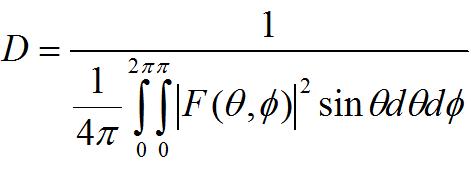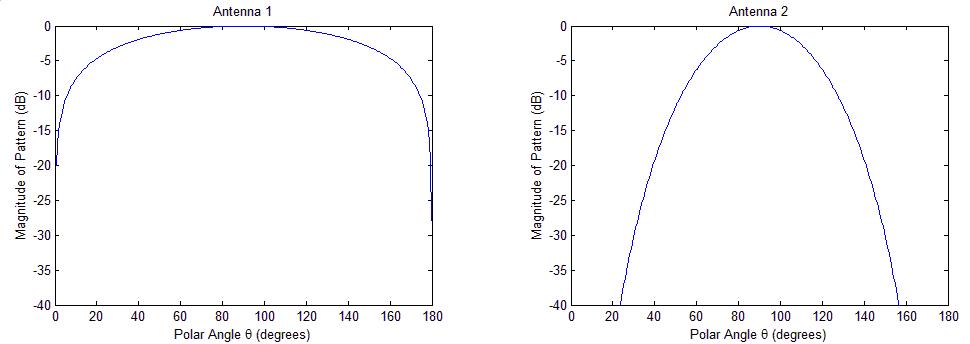Directivity
|
Directivity is a fundamental antenna parameter. It is a measure of how 'directional' an antenna's radiation pattern is. An antenna that radiates equally in all directions would have effectively zero directionality, and the directivity of this type of antenna would be 1 (or 0 dB). [Silly side note: When a directivity is specified for an antenna, what is meant is 'peak directivity'. Directivity is technically a function of angle, but the angular variation is described by its radiation pattern. Hence, directivity throughout this page will mean peak directivity, because it is rarely used in another context.] An antenna's normalized radiation pattern can be written as a function in spherical coordinates:
A normalized radiation pattern is the same as a radiation pattern; it is just scaled in magnitude such that the peak (maximum value) of the magnitude of the radiation pattern (F in equation [1]) is equal to 1. Mathematically, the formula for directivity (D) is written as:

Directivity ExampleAs an example consider two antennas, one with radiation patterns given by:
 Antenna 1 Antenna 1
 , and not a function of
the azimuth angle (uniform in azimuth). The radiation pattern for antenna 1
is less directional then that for antenna 2; hence we expect the directivity to be lower. , and not a function of
the azimuth angle (uniform in azimuth). The radiation pattern for antenna 1
is less directional then that for antenna 2; hence we expect the directivity to be lower.
|

|
Using Equation [1], we can figure out which antenna has the higher directivity. But to check your understanding, you should think about Figure 1 and what directivity is, and determine which has a higher directivity without using any mathematics. The results of the directivity calculation, using Equation [1]: The directivity is calculated for Antenna 1 to be 1.273 (1.05 dB). The directivity is calculated for Antenna 2 to be 2.707 (4.32 dB).
Again, increased directivity implies a more 'focused' or 'directional' antenna. In words, Antenna 2 receives 2.707 times more power in its peak direction than an isotropic antenna would receive. Antenna 1 would receive 1.273 times the power of an isotropic antenna. The isotropic antenna is used as a common reference, even though no perfectly isotropic antennas actually exist. [Side note: Sometimes you will see an antenna in a datasheet labelled as isotropic; what they mean is it is isotropic in one major plane; for instance a dipole antenna has a perfectly symmetric radiation pattern in the x-y plane, or azimuth plane, and is sometimes referred to as isotropic. Just note it is not isotropic in the elevation plane.] Antennas for cell phones should have a low directivity because the signal can come from any direction, and the antenna should pick it up. In contrast, satellite dish antennas have a very high directivity, because they are to receive signals from a fixed direction. As an example, if you get a directTV dish, they will tell you where to point it such that the antenna will receive the signal. Finally, we'll conclude with a list of antenna types and their directivities, to give you an idea of what is seen in practice.
|
| Antenna Type | Typical Directivity | Typical Directivity (dB) |
|---|---|---|
| Short Dipole Antenna | 1.5 | 1.76 |
| Half-Wave Dipole Antenna | 1.64 | 2.15 |
| Patch (Microstrip) Antenna | 3.2-6.3 | 5-8 |
| Horn Antenna | 10-100 | 10-20 |
| Dish Antenna | 10-10,000 | 10-40 |
|
As you can see from the above table, the directivity of an antenna can vary over several order of magnitude. Hence, it is important to understand directivity in choosing the best antenna for your specific application. If you need to transmit or receive energy from a wide variety of directions (example: car radio, mobile phones, computer wifi), then you should design an antenna with a low directivity. Conversely, if you are doing remote sensing, or targetted power transfer (example: received signal from a mountain top), you want a high directivity antenna in order to maximize power transfer and reduce signal from unwanted directions.
A Little Bit of Antenna DesignLet's say we decide that we want an antenna with a low directivity. How do we accomplish this?
The general rule in Antenna Theory is that you need an electrically small antenna to produce
low directivity. That is, if you use an antenna with a total size of 0.25 - 0.5 Conversely, for antennas with a high directivity, we'll need antennas that are many wavelengths in size. That is, antennas such as dish (or satellite) antennas and horn antennas have high directivity, in part because they are many wavelengths long.
Why is this? [I don't know how to explain this without getting mathematical, sorry!]
Ultimately, it has to do with the properties of the Fourier Transform.
When you take the Fourier Transform of a short pulse, you get a broad frequency spectrum. The analogy is present
in determining the radiation pattern of an antenna: the pattern can be thought of as the Fourier Transform of
the antenna's current or voltage distribution. As a result, small antennas have broad radiation patterns
(low directivity), and antennas with large uniform voltage or current distributions have
very directional patterns (and thus, a high directivity).
Antenna Basics Menu (Home) Antennas
This directivity page is copyrighted. It can be reproduced without permission from the author as long as the source is cited/referenced. Copyright antenna-theory.com, 2009-2021.
|

 Antenna 2
Antenna 2 (a quarter- to a half-wavelength in size), then you will minimize directivity. That is,
(a quarter- to a half-wavelength in size), then you will minimize directivity. That is,